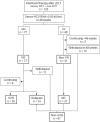Pretransplant serum hepatitis C virus RNA levels predict response to antiviral treatment after living donor liver transplantation
- PMID: 23505497
- PMCID: PMC3591322
- DOI: 10.1371/journal.pone.0058380
Pretransplant serum hepatitis C virus RNA levels predict response to antiviral treatment after living donor liver transplantation
Erratum in
- PLoS One. 2013;8(11). doi:10.1371/annotation/1601274b-def0-4970-8e61-62e657c2d1ae
Abstract
Background: Given the limited efficacy and high adverse event rate associated with treatment of recurrent hepatitis C after liver transplantation, an individualized treatment strategy should be considered. The aim of this study was to identify predictors of response to antiviral therapy for hepatitis C after living donor liver transplantation (LDLT) and to study the associated adverse events.
Methods: A retrospective chart review was performed on 125 hepatitis C virus (HCV)-positive LDLT recipients who received interferon plus ribavirin and/or peginterferon plus ribavirin therapy at Kyoto University between January 2001 and June 2011.
Results: Serum HCV RNA reached undetectable levels within 48 weeks in 77 (62%) of 125 patients, and these patients were defined as showing virological response (VR). Of 117 patients, 50 (43%) achieved sustained VR (SVR). Predictive factors associated with both VR and SVR by univariate analysis included low pretransplant serum HCV RNA levels, a non-1 HCV genotype, and low pretreatment serum HCV RNA levels. In addition, LDLT from ABO-mismatched donors was significantly associated with VR, and white cell and neutrophil counts before interferon therapy were associated with SVR. Multivariate analysis showed that 2 variables-pretransplant serum HCV RNA level less than 500 kIU/mL and a non-1 HCV genotype-remained in models of both VR and SVR and that an ABO mismatch was associated with VR. No variables with a significant effect on treatment withdrawal were found.
Conclusions: Virological response to antiviral therapy in patients with hepatitis C recurring after LDLT can be predicted prior to transplant, based on pretransplant serum HCV-RNA levels and HCV genotype. LDLT from ABO-mismatched donors may contribute to more efficacious interferon therapy.
Trial registration: UMIN-CTR UMIN000003286.
Conflict of interest statement
Figures

Similar articles
-
Identification of novel defective HCV clones in liver transplant recipients with recurrent HCV infection.J Viral Hepat. 2006 Aug;13(8):523-31. doi: 10.1111/j.1365-2893.2006.00760.x. J Viral Hepat. 2006. PMID: 16901282
-
Pegylated interferon plus ribavirin in HIV-infected patients with recurrent hepatitis C after liver transplantation: a prospective cohort study.J Hepatol. 2015 Jan;62(1):92-100. doi: 10.1016/j.jhep.2014.07.034. Epub 2014 Aug 13. J Hepatol. 2015. PMID: 25127748
-
Undetectable hepatitis C virus RNA at week 4 as predictor of sustained virological response in HIV patients with chronic hepatitis C.AIDS. 2008 Jan 2;22(1):15-21. doi: 10.1097/QAD.0b013e3282f1da99. AIDS. 2008. PMID: 18090387
-
Molecular diagnostics in the management of chronic hepatitis C: key considerations in the era of new antiviral therapies.BMC Infect Dis. 2014;14 Suppl 5(Suppl 5):S8. doi: 10.1186/1471-2334-14-S5-S8. Epub 2014 Sep 5. BMC Infect Dis. 2014. PMID: 25236936 Free PMC article. Review.
-
Paradigm Shift in Utilization of Livers from Hepatitis C-Viremic Donors into Hepatitis C Virus-Negative Patients.Clin Liver Dis. 2021 Feb;25(1):195-207. doi: 10.1016/j.cld.2020.08.009. Epub 2020 Nov 5. Clin Liver Dis. 2021. PMID: 33978579 Review.
References
-
- Berenguer M, Prieto M, San Juan F, Rayon JM, Martinez F, et al. (2002) Contribution of donor age to the recent decrease in patient survival among HCV-infected liver transplant recipients. Hepatology 36: 202–210. - PubMed
-
- Feray C, Caccamo L, Alexander GJ, Ducot B, Gugenheim J, et al. (1999) European collaborative study on factors influencing outcome after liver transplantation for hepatitis C. European Concerted Action on Viral Hepatitis (EUROHEP) Group. Gastroenterology 117: 619–625. - PubMed
-
- Forman LM, Lewis JD, Berlin JA, Feldman HI, Lucey MR (2002) The association between hepatitis C infection and survival after orthotopic liver transplantation. Gastroenterology 122: 889–896. - PubMed
-
- Gane E (2003) The natural history and outcome of liver transplantation in hepatitis C virus-infected recipients. Liver Transpl 9: S28–34. - PubMed
-
- Prieto M, Berenguer M, Rayon JM, Cordoba J, Arguello L, et al. (1999) High incidence of allograft cirrhosis in hepatitis C virus genotype 1b infection following transplantation: relationship with rejection episodes. Hepatology 29: 250–256. - PubMed
Publication types
MeSH terms
Substances
LinkOut - more resources
Full Text Sources
Other Literature Sources

